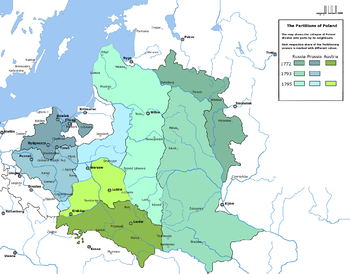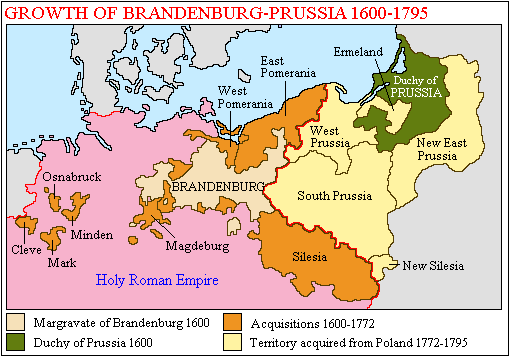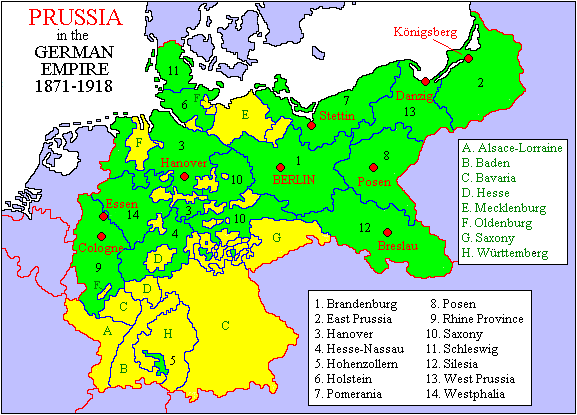
Prussian partition
Encyclopedia



Polish-Lithuanian Commonwealth
The Polish–Lithuanian Commonwealth was a dualistic state of Poland and Lithuania ruled by a common monarch. It was the largest and one of the most populous countries of 16th- and 17th‑century Europe with some and a multi-ethnic population of 11 million at its peak in the early 17th century...
acquired during the partitions of Poland
Partitions of Poland
The Partitions of Poland or Partitions of the Polish–Lithuanian Commonwealth took place in the second half of the 18th century and ended the existence of the Polish–Lithuanian Commonwealth, resulting in the elimination of sovereign Poland for 123 years...
in the late 18th century by the Kingdom of Prussia
Kingdom of Prussia
The Kingdom of Prussia was a German kingdom from 1701 to 1918. Until the defeat of Germany in World War I, it comprised almost two-thirds of the area of the German Empire...
.
History
The Kingdom of PrussiaKingdom of Prussia
The Kingdom of Prussia was a German kingdom from 1701 to 1918. Until the defeat of Germany in World War I, it comprised almost two-thirds of the area of the German Empire...
(known from the second half of the 19th century as the German Empire
German Empire
The German Empire refers to Germany during the "Second Reich" period from the unification of Germany and proclamation of Wilhelm I as German Emperor on 18 January 1871, to 1918, when it became a federal republic after defeat in World War I and the abdication of the Emperor, Wilhelm II.The German...
) acquired Polish territories in all three partitions; it was also their major instigator.
Major historical events of the Prussian partition include:
- formation of the Napoleonic Duchy of WarsawDuchy of WarsawThe Duchy of Warsaw was a Polish state established by Napoleon I in 1807 from the Polish lands ceded by the Kingdom of Prussia under the terms of the Treaties of Tilsit. The duchy was held in personal union by one of Napoleon's allies, King Frederick Augustus I of Saxony...
(1807) and its abolition after the Congress of ViennaCongress of ViennaThe Congress of Vienna was a conference of ambassadors of European states chaired by Klemens Wenzel von Metternich, and held in Vienna from September, 1814 to June, 1815. The objective of the Congress was to settle the many issues arising from the French Revolutionary Wars, the Napoleonic Wars,...
(1815) - Greater Poland Uprising (1806)
- Greater Poland Uprising (1846)
- Greater Poland Uprising (1848)
- Greater Poland Uprising (1918–1919)Greater Poland Uprising (1918–1919)The Greater Poland Uprising of 1918–1919, or Wielkopolska Uprising of 1918–1919 or Posnanian War was a military insurrection of Poles in the Greater Poland region against Germany...
Administrative division
The Kingdom of Prussia divided the former territories of the Commonwealth it obtained into:- Netze DistrictNetze DistrictThe Netze District or District of the Netze was a territory in the Kingdom of Prussia from 1772 until 1807. It included the urban centers of Bydgoszcz , Inowrocław , Piła and Wałcz and was given its name for the Noteć River that traversed it.Beside Royal Prussia, a land of the Polish Crown...
- from 1772 to 1793 - New SilesiaNew SilesiaNew Silesia was a small province of the Kingdom of Prussia from 1795 to 1807, created after the Third Partition of Poland. It was located northwest of Kraków and southeast of Częstochowa, in the lands that had been part of the Silesian Duchy of Siewierz and the adjacent Polish historical province...
- from 1795 to 1807 - New East PrussiaNew East PrussiaNew East Prussia was a province of the Kingdom of Prussia from 1795 to 1807. It was created out of territory annexed in the Third Partition of Poland and included parts of Masovia and Podlaskie...
- from 1795 to 1807 - South PrussiaSouth PrussiaSouth Prussia was a province of the Kingdom of Prussia from 1793 to 1807. It was created out of territory annexed in the Second Partition of Poland and included in 1793*the Poznań, Kalisz and Gniezno Voivodeships of Greater Poland;...
- from 1793 to 1806 - East PrussiaEast PrussiaEast Prussia is the main part of the region of Prussia along the southeastern Baltic Coast from the 13th century to the end of World War II in May 1945. From 1772–1829 and 1878–1945, the Province of East Prussia was part of the German state of Prussia. The capital city was Königsberg.East Prussia...
- from 1773-1829 - West PrussiaWest PrussiaWest Prussia was a province of the Kingdom of Prussia from 1773–1824 and 1878–1919/20 which was created out of the earlier Polish province of Royal Prussia...
- from 1773-1824
In the first partition, Prussia received 36,000 km² and about 600,000 people. In the second partition, Prussia received 58,000 km² and about 1 million people. In the third, similar to the second, Prussia gained 55,000 km² and 1 million people. Overall, Prussia gained about 20 percent of the former Commonwealth territory 149 000km²) and about 23 percent of the population (2.6 million people). From the geographical perspective, most of the territories annexed by Prussia formed the province of Greater Poland
Greater Poland
Greater Poland or Great Poland, often known by its Polish name Wielkopolska is a historical region of west-central Poland. Its chief city is Poznań.The boundaries of Greater Poland have varied somewhat throughout history...
(Wielkopolska).
Over time the administrative divisions changed. Important Prussian administrative divisions of Polish lands included:
- Grand Duchy of Posen from 1815–1848
- Province of PosenProvince of PosenThe Province of Posen was a province of Prussia from 1848–1918 and as such part of the German Empire from 1871 to 1918. The area was about 29,000 km2....
from 1848–1919
Society
Poles in the Prussian partition were subject to extensive Germanization policies (KulturkampfKulturkampf
The German term refers to German policies in relation to secularity and the influence of the Roman Catholic Church, enacted from 1871 to 1878 by the Prime Minister of Prussia, Otto von Bismarck. The Kulturkampf did not extend to the other German states such as Bavaria...
, Hakata
German Eastern Marches Society
German Eastern Marches Society was a German radical, extremely nationalist xenophobic organization founded in 1894. Mainly among Poles, it was sometimes known acronymically as Hakata or H-K-T after its founders von Hansemann, Kennemann and von Tiedemann...
). Frederick the Great brought up 300.000 colonists on territories he conquered to facilitate Germanization.
That policy, however, had an opposite effect to that which the German leadership had expected: instead of becoming assimilated, the Polish minority in Germany became more organized, and its national consciousness grew. Of the three partitions, the education system in Prussia was on a much higher level than in Austria or Russia.
Economy
From the economic perspective, the territories of the Prussian partitions were the most developed, thanks to the progressive policies of the Prussian government. The German government supported efficient farming, industry, financial institutions and transport.Further reading
- Norman Davies: God's PlaygroundGod's PlaygroundGod's Playground is a book written in 1979 by Norman Davies, covering the history of Poland.Davies was inspired to the title by Jan Kochanowski's 1580s Boże igrzysko ....
, p. 83-101: PREUSSEN: The Prussian Partition (1772-1918)

